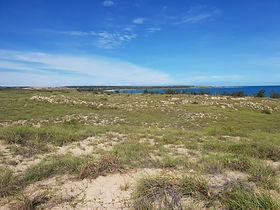

PROTECTING THE NORTHERN HOPPING-MOUSE
![3paul_barden_hopping_mouse[1].JPG](https://static.wixstatic.com/media/da28f0_eac30f23f5db4d619bf45f4783ff782c~mv2_d_5760_3840_s_4_2.jpg/v1/crop/x_0,y_291,w_5760,h_3258/fill/w_488,h_276,al_c,q_80,usm_0.66_1.00_0.01,enc_auto/3paul_barden_hopping_mouse%5B1%5D_JPG.jpg)
The endangered northern hopping-mouse (Notomys aquilo) Photo: Paul Barden”
Territory Natural Resource Management is working with the Anindilyakwa Land and Sea Rangers and Traditional Owners to maintain or improve the abundance of the northern hopping-mouse, listed as Vulnerable in the Northern Territory.
This project is supported by funding from the Australian Government’s National Landcare Program and will facilitate strategic management of threats (particularly cats and weeds) to protect the northern hopping-mouse population on Groote Eylandt, off the eastern coast of Arnhem Land.
OUR WORK
This project follows a previous Australian Government National Landcare Program funded project ‘In search of the northern hopping-mouse.’ In this project, TNRM collaborated with Indigenous ranger groups (Bawinanga, Warddeken, and Dhimurru Rangers) to conduct targeted surveys in 2018 and 2019 across the Arnhem Land mainland at sites where the northern hopping-mouse historically occurred but had not been seen for a long time. Intensive surveys were also carried out on Groote Eylandt with the Anindilyakwa Land and Sea Rangers, where the species is currently known to inhabit. These surveys aimed to improve knowledge of the species’ distribution and identify threats and habitat condition at current and historic locations. Unfortunately, the northern hopping-mouse was not located on the mainland, so it may now only be found on Groote Eylandt in the Anindilyakwa Indigenous Protected Area (IPA). This work highlighted that it is more important than ever to manage threats and monitor the species to ensure the northern hopping-mouse continues to persist in the future.
TNRM continues to work with Indigenous land managers on Groote Eylandt to monitor hopping-mice sub-populations and their response to threats, conduct threat management, and trial and adopt survey methodology for ongoing monitoring and management. Weeds and cats are the key threats for which management activities are undertaken through this project.
PROJECT AIMS
-
Monitor northern hopping-mouse sub-populations on Groote Eylandt through:
-
Ground-based and drone surveys to trial different methods of estimating the relative abundance of the species
-
Comparing relative abundance estimates from the different methods to make recommendations for future monitoring activities
-
ABOUT THE NORTHERN HOPPING-MOUSE
The northern hopping-mouse (Notomys aquilo) is a native Australian rodent with bulging eyes, big ears, a long tail, and huge feet, on which it hops around like a miniature kangaroo.
Females of the species construct underground burrows of 2 to 5 metres in length, leaving behind a pile of soil known as a “spoil heap” and creating 2 to 6 burrow entrance holes known as “pop holes”. Surveys for the species involve looking for spoil heaps and pop holes and setting camera traps to capture images of the mice. New technologies, such as drones, are being investigated for their potential survey use.
SAVING THE SPECIES
The northern hopping-mouse is the only hopping-mouse that occurs outside of the arid zone. It has recently been upgraded to Endangered under federal legislation (EPBC Act 1999) and is listed as Vulnerable in the Northern Territory (Territory Parks and Wildlife Conservation Act 1976).
The species has not been recorded on the mainland in decades and Groote Eylandt may now be their last remaining refuge. Years of thorough targeted searching on Groote has identified a number of areas where hopping-mice appear to be doing well in open woodlands with sandy soil, and in several locations on eastern coastal dunes.
Information obtained from northern hopping-mouse surveys in 2018-2019 by Territory NRM and four Indigenous Ranger groups on Groote Eylandt and mainland Arnhem Land contributed to the status up-listing of the species from Vulnerable to Endangered.

Anindilyakwa Land and Sea rangers spraying weeds in northern hopping-mouse habitat
-
Manage threats in known hopping-mouse occupied habitat by:
-
Supporting accredited chemical training for the Anindilyakwa land and sea rangers
-
Supporting the rangers to remove weeds in targeted locations in known northern hopping-mouse habitat
-
Working with Animal Management in Rural and Remote Indigenous Communities (AMRRIC) to conduct community cat awareness in schools and communities
-
Supporting the East Arnhem Regional Council’s animal management veterinarian to carry out neutering activities in communities and outstations to help people manage their cats in community
-
-
Inform conservation by:
-
Using knowledge gained from surveys to inform future monitoring and threat management activities by the Anindilyakwa land and sea rangers.
-